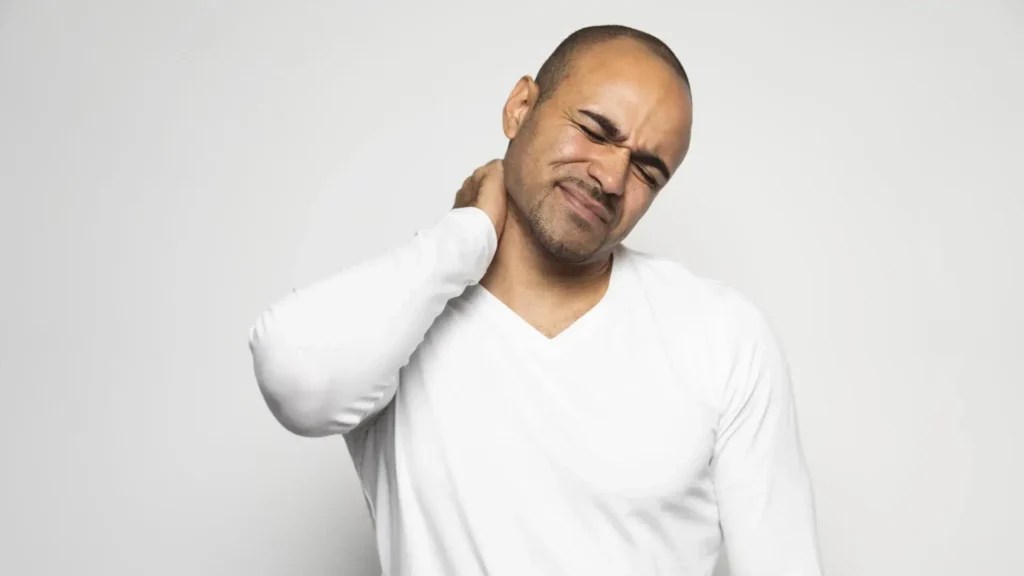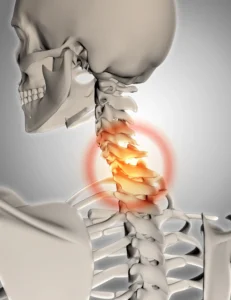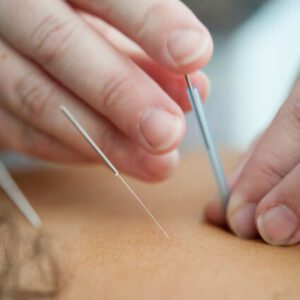
Do you usually arrive at the end of the day with a tired neck and shoulders, or in pain?
These days, most people have had the opportunity to telework, from the comfort of their homes. But is it always that comfortable? Not always, not for everyone. In this article we will talk about risk factors, some of the causes of shoulder and neck pain, mention some advantages and disadvantages of teleworking, and provide simple strategies to deal with the situation.
The name given to this type of pain, which does not exactly have a defined cause, is Nonspecific Neck Pain. This DCI is defined as pain in the posterior and lateral region of the neck between the top line of the neck and the spinous process of the first thoracic vertebra (pain between the head and the beginning of the shoulders/dorsal spine), without signs or symptoms of major structural pathology. and no or minor interference with activities of daily living. DCI is also characterized by the absence of neurological signs and specific pathologies; such as: traumatic sprain and fracture, osteoarthritis or cervical spondylolysis.
People who have a defined cause for their neck pain, such as: radiculopathy, facet joint pain, herniated discs, or chronic rheumatic diseases are said to have Cause-Specific Neck Pain.
Risk factors
Within a “Bio-Psychosocial” framework, several factors can be considered as contributing to ICD. Risk factors are multidimensional, and can be divided into individual and occupational factors.
Individual factors include:
-
- gender
-
- advanced age
-
- being a smoker
-
- history of previous neck or lumbar spine injury
-
- psychological factors (e.g. stress, expectations and (dis)satisfaction at work, anxiety, depression and lack of social support)
Occupational factors include:
-
- long hours of sedentary or office work,
-
- high workload (increased by being at home),
-
- inadequate workstation (living room chair, living room or kitchen table, laptop)
Nevertheless, the factors considered most predisposing to these symptoms are: being a woman and/or having a previous history of pain in the neck and shoulder region.
As we saw in the article The benefits and importance of Physiotherapy, when you feel pain in your back and seek help, your treatment may include correcting a dysfunction in your foot or learning how to stretch some muscles in your lower limbs. But not only that, as we will see later. One of the methods that can be used for this purpose is Global Postural Reeducation created by Philippe Souchard, French physiotherapist, or his self-posture method, Active Global Stretching.
Nonspecific Neck Pain is a highly common musculoskeletal disorder and one of the main causes of disability worldwide. It is well established that neck pain is not only a risk factor for serious spinal problems and functional incapacity, but which is also associated with a decrease in the quality of life and productivity of workers.
Prevalence rates show that around two in three people will experience neck pain at some point during their lifetime. As mentioned, they show that women are more likely than men to have these symptoms, and even more likely to present generalized hyperalgesia due to recurrent visceral pain. Next we will see what visceral pain is.


Causes of Neck Pain
Most pain in the cervical region, as we have seen, is of non-specific origin, that is, it is not possible to assign a cause. These are normally related to postural changes and myofascial tensions ( muscles and fascia), emotional and mental stress, and/or even poor sleep hygiene. Which means that with the help of therapies (physiotherapy, massage, osteopathy), therapeutic exercise (physiotherapist or personal trainer), and changing harmful habits (fast food, soft drinks, alcohol, tobacco, sleeping a few hours, drinking little water) to healthier ones (healthy eating, meditating, drinking at least 1.5L of water a day, exercising at least less than 3 times a week), relief of complaints can be achieved.
Let’s see how tension can contribute to pain. We normally associate that problems in the neck and shoulders are only related to changes in these same areas. However, one must always consider the possibility of tensions associated with:
Let’s see how tension can contribute to pain. We normally associate that problems in the neck and shoulders are only related to changes in these same areas. However, one must always consider the possibility of tensions associated with:
-
- hand and elbow (due to working with the computer mouse)
-
- to the mouth joint (Temporo-Mandibular Joint) due to stress or teeth problems
-
- muscular dysfunctions and tensions at the level of the transition between the cervical and dorsal spine
-
- loss of mobility in the lower back and hips (excessive tension in the glutes makes it difficult to sit)
In a physiotherapy session you can count on a global assessment, in which the therapist seeks to know the entire history of your injury, as well as other pertinent information (topic to be discussed in another article). When a person complains of neck and shoulder pain, it is always important to look in the clinical history for other signs and symptoms that may lead to suspicion of another type of disease, typically associated with generalized inflammation.
One of the symptoms that can make us suspect other causes is the existence of morning stiffness, which improves throughout the day. In this case, there is a good chance that there are rheumatological conditions (rheumatoid arthritis, ankylosing spondylitis or fibromyalgia), but they generally do not occur in isolation. If it is a rheumatological condition, there is generalized joint involvement, that is, there is the same type of symptoms in several joints of the body. However, to make an accurate diagnosis, it is best to consult an orthopedist or rheumatologist.
Another possible cause for the existence of neck pain is the existence of visceral pathologies (gastric ulcers, fatty liver or other disorders of this organ, or even gallstones). Through the connections between the nerves and the organs, this possibility of pain referred from a distance is justified, that is, neck pain originating in the organs and viscera. To learn more about this topic you can read the book Dor Para Quê.
Understanding (on the part of the doctor or therapist) and awareness of the referred pain are essential for an accurate diagnosis of the source of pain.

Evaluation
The healthcare professional receiving a person complaining of shoulder and neck pain should perform assessments to determine the potential for the presence of serious pathology (e.g., infection, arterial insufficiency, superior cervical ligament insufficiency, or other dysfunction). ) and refer for consultation as needed.
One of the ways to evaluate and measure the symptoms that a person complains about is a scale, such as the Neck Disability Index (Neck Disability Index). On this scale, questions are asked about:
-
- Intensity of pain
-
- Personal care
-
- Lift things
-
- Reading
-
- Headaches
-
- Pay attention
-
- Work
-
- Driving cars
-
- Sleep
-
- Fun
When evaluating a patient with neck pain, check whether there is, for example:
-
- neck pain with mobility deficits
-
- mobility tests for the chest and cervical region
-
- neck pain that causes headache
-
- neck pain with radiating pain
Strategies
There are very simple things we can do throughout our day-to-day work that allow us to reach the end of the day much more comfortable. Let’s look at some:
-
- Have the computer monitor in front of us (not to the side)
-
- Having the top of the screen at eye level. For those who work with a laptop, one of the solutions is to place the laptop on a higher area (with books, for example), and work on a separate keyboard, resting on the desk
-
- Use a vertical mouse instead of the normal mouse
-
- Get up every hour and do some stretching movements with your arms and neck
-
- Perform stretches for all major muscle groups (chest, back, front of thighs, back of thighs and legs) before and after work
-
- Try to have healthy snacks between meals (such as a fruit or a handful of nuts), instead of bread, cakes, or other processed foods
Treatment
Neck pain can be acute, sub-acute or chronic. For each situation, treatment can and should be differentiated according to the latest guidelines published. For more information about chronic pain you can consult our e-book “Chronic Pain – Integrative Treatment“.
Conservative treatments (i.e., non-surgical or invasive) used to help manage Non-Specific Neck Pain are numerous and include conventional (CT) and non-conventional (TNC) therapies:
-
- Physical therapy (which includes manual therapies, electrotherapy, therapeutic exercise and health education)
-
- Pilates, Global Postural Reeducation, Yoga or other type of personalized therapeutic training
-
- Traditional Chinese Medicine (including acupuncture)
-
- Nutrition and/or Naturopathy (nutritional advice and dietary supplements adapted to each case)
-
- Massage
-
- Relaxation techniques and mind-body practices (meditation, mindfulness, or other related practices)
-
- Medication (preferably advised by the attending physician – family doctor, occupational physician, orthopedist or rheumatologist, for example).
You can read more about some simple Relaxation techniques in the article “Awareness – Why is it important to be self-aware?”.
Did you like this article? Share it with anyone who could benefit from this information or leave us a message.
References
The efficacy of manual therapy and exercise for treating non-specific neck pain: A systematic review.
Chronic Neck Pain: Nonpharmacologic Treatment
Neck pain: What if it is not musculoskeletal?
Visceral Origin: An Underestimated Source of Neck Pain. A Systematic Scoping Review
Cost-effectiveness of conservative treatments for neck pain: a systematic review on economic evaluations
Neck Pain: Revision 2017






